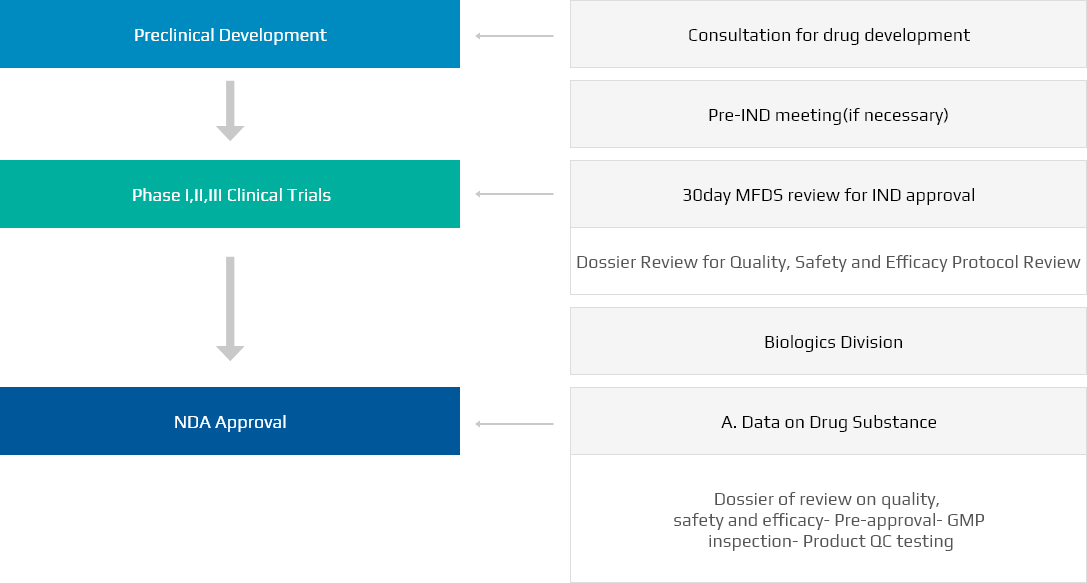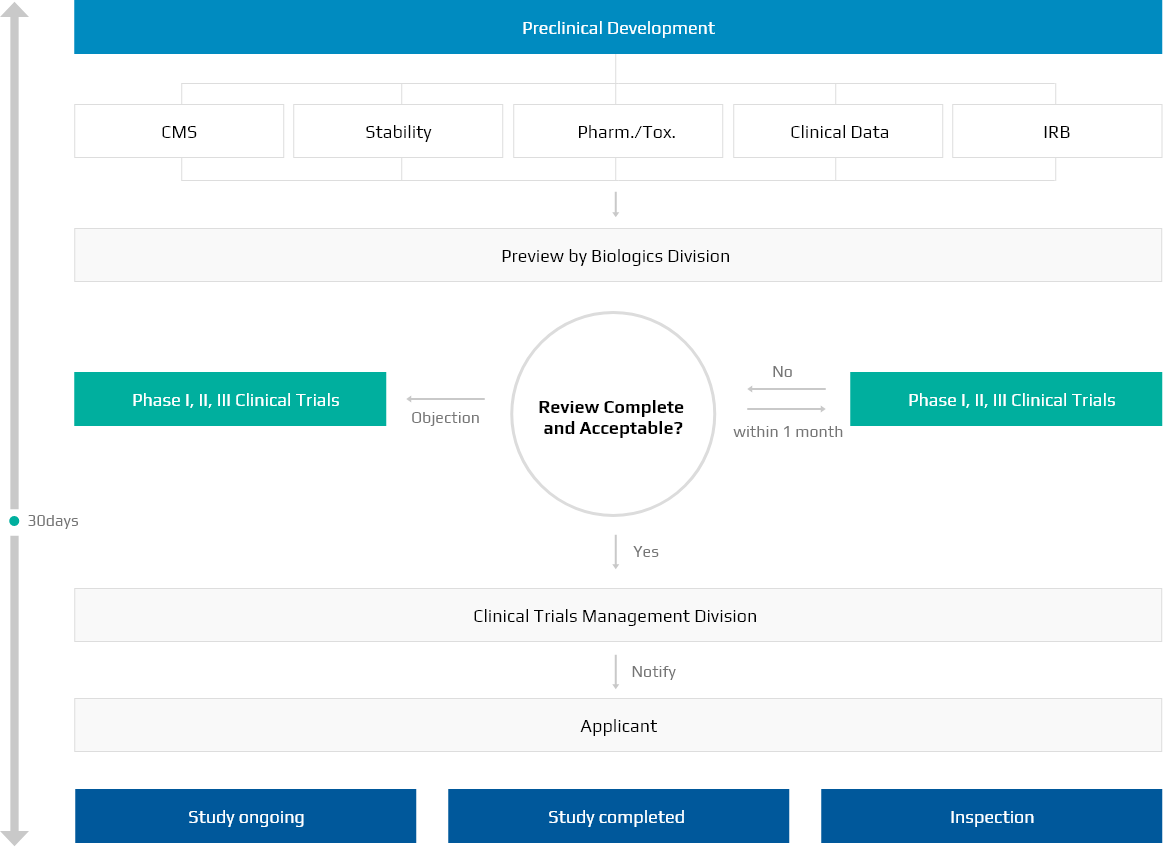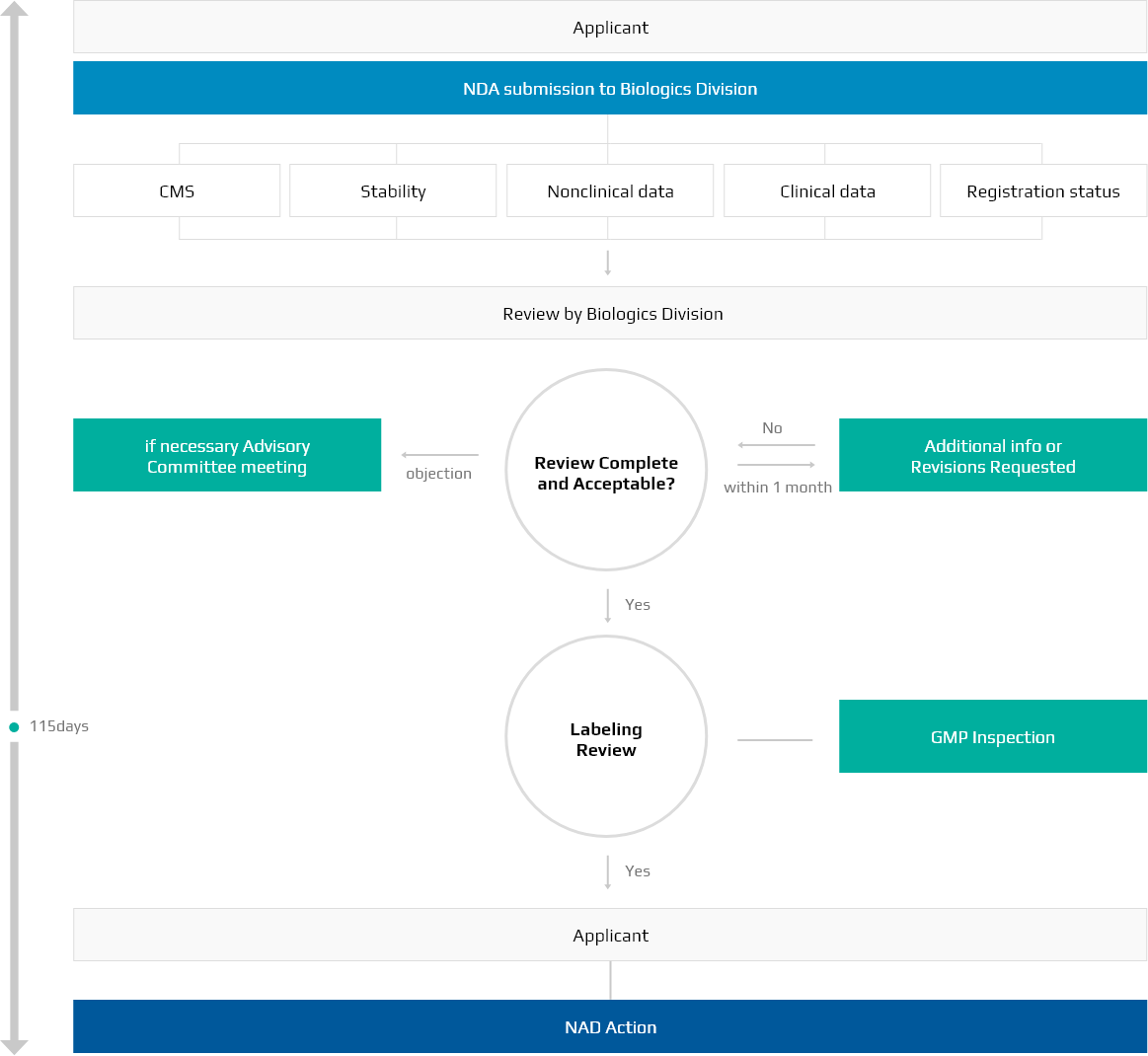Biological Products
home Korea Pharmaceutical Industry Information Drug Regulations Biological Products
Organization & Main Tasks

Biopharmaceuticals and Herbal Medicines Bureau
- Establishes and coordinates safety management policies for biopharmaceuticals; creates and revises policies for biopharmaceuticals, transplantation materials and blood plasma
- Supports exports and involves in international cooperation
Biopharmaceutical Quality Management Division
- Establishes and runs comprehensive domestic/international inspection plans regarding biopharmaceutical manufacturing, quality management criteria and human transplantation materials management
- Establishes and coordinates biopharmaceutical supervision/monitoring plans; establishes/runs GMP training/capability building plans
Herbal Medicines Policy Division
- Establishes and coordinates policies; implements and revises rules and regulations; engages in international cooperation; grants market authorization of domestically-manufactured/imported products and develops relevant policies in herbal medicines
Cosmetics Policy Division
- Establishes and coordinates policies; implements and revises rules, regulations, and notifications; makes and coordinates monitoring plans in cosmetics products
Quasi-drugs Policy Division
- Establishes and coordinates policies; implements and revises rules, regulations, and notifications; makes and coordinates monitoring plans; grants market authorization of domestically-manufactured/imported products and develops relevant policies in quasi-drugs
Biopharmaceuticals and Herbal Medicines Evaluation Department

Biologics Division
- Reviews and evaluates quality, safety and efficacy of biological and biopharmaceutical diagnostics products
- Approves domestic and import related products
Recombinant Products Division
- Reviews and evaluates quality, safety and efficacy of recombinants
- Approves domestic and import related products
Cell and Gene Therapy Products Division
- Reviews and evaluates quality, safety and efficacy of cell therapies, gene therapies, and tissue-engineered products
- Approves domestic and import related products
Herbal Medicines Products Division
- Reviews and evaluates quality, safety and efficacy of herbal medicines
- Approves domestic and import related products
Herbal Medicines Products Division
- Reviews and evaluates quality, safety and efficacy of cosmetics and quasi medicines
- Approves domestic and import related products
Control of Biologics
Biopharmaceutical Policy Division
- Establishes and revises policies for biologics
- Supports exports and involves in international cooperation
Biopharmaceutical Quality Management Division
- Coordinates administrative word: PMS, GMP inspection
- Coordinates all compliance actions: product recalls, regulatory letters
Biologics Division
- Coordinates administrative work: Market authorization for biologics
- Evaluates CMC section
- Evaluates pharmacology, toxicology and clinical data section
- Supports GMP, GLP, GCP compliance
National Center for lot Release
- Performs official lot release tests of biologics (3 Teams)
- Conducts laboratory research relating to testing method and national STD.
Biologics Research Division
- Conducts research of vaccine effectiveness
- Collaborative Activities with WHO
Approval Process
1. From Development to Authorization

*Sponsors have submitted application as electronic documents through KIFDA online system since Oct. 2nd, 2006.
2. IND (Investigational New Drug Application) Review Process

2-1. Dossier for IND
- 1. Development plan
- 2. Introduction
- 3. Data on structural identification and psychochemical and biological properties (including data for a placebo)
- 4. Data on non-clinical studies
- Data on Pharmacology
- Data on Toxicity
- 5. Data on clinical studies (if applicable)
- 6. Study protocol
- 7. References
- 8. Investigator’s Brochure (IB)
3. NDA (New Drug Application) Review Process

3-1. Dossier for NDA(BLA)
- Origin or backgrounds leading up to discovery and development
- Stability test data
- Drug substance
- Drug product long-term accelerated, stressed
- Pharmacologic effects
- Efficacy studies data
- Safety or general pharmacology studies data
- ADME
- Other pharmacologic effects
- Uses in other countries
- Structure·Physical, chemical and biological nature
- Drug substance
- Drug product
- Toxicity
- Single dose toxicity
- Repeated dose toxicity
- Genetic toxicity
- Carcinogenicity
- Reproductive and developmental toxicity
- Other antigenicity, immunotoxcity, local toxicity dependency, etc.
- Clinical Data
- Clinical Data package
- Bridging Data
- Comparison with domestic copies & special features of the drug concerned
Quasi-Drugs
1. What are Quasi-Drugs?
- The term “Quasi-Drugs” means items (goods constituting medicines shall be excluded here after) designated by the Minister of Food and Drug Safety (hereinafter referred to as the Minister of MFDS), falling under any of the following:
- Fibers, rubber products or other similar products intended to be used for treating, reducing, or preventing diseases in humans and animals
- Non-equipment or non-machinery products that have minimal effect or do not have a direct effect on humans, or other similar products
- Products intended to be used for disinfection, insecticide, or other similar purposes to prevent infectious diseases.
※ Classification of quasi-drugs into three groups pursuant to the ‘Designation of the Scope of Quasi-Drugs (Notice of Ministry of Food and Drug Safety)
| Item Category | Remark | ||
|---|---|---|---|
| Group 1 | A. Sanitary Pad | 1) Menstrual Pad | Fibers, rubber or similar products used for sanitary purposes |
| 2) Menstrual Tampon | |||
| B. Mask | 1) Surgical mask | ||
| 2) Dust mask | |||
| C. Sanitary products used for preservation, protection, and treatment, etc. of the affected area | 1) Eye Bandage | ||
| 2) Bandage | |||
| 3) Elastic bandage | |||
| 4) Plaster bandage | |||
| 5) Cylindrical elastic bandage (Stokinet) | |||
| 6) Absorbent Gauze | |||
| 7) Absorbent Cotton | |||
| 8) Adhesive Plaster | |||
| D. Wet wipes for oral hygiene | |||
| E. Other similar products | |||
| Group 2 | A. Odor inhibitors such as bad breath (halitosis) eliminators | 1) Mouth fresheners (for internal use and mouthrinses) | Products that have minimal effect or do not have a direct effect on human |
| 2) Antiperspirants (for external use only) | |||
| 3) Products for heat rash and skin erosion treatment | |||
| 4) Toothpastes | |||
| 5) Bath products (for external use only) | |||
| B. Products used for preventing hair loss, dying hair (including bleaching and removing dye from hair) and depilating etc. | 1) Anti-hair loss products | ||
| 2) Hair dye (including bleaching and dye-removing products) | |||
| 3) Depilatories (for external use only) | |||
C. Extirpators, inhibitors, repellents and insect-attracting pesticides for flies and mosquitoes, etc.
|
|||
| D. Contact Lens Care Products | |||
| E. Products that do not contain nicotine, falling under the following | 1) Products aiding in reducing the urge to smoke | ||
| 2) Products aiding in improving smoking habits | |||
| F. Externally applied disinfectants used directly on humans (Main ingredients: hydrogen peroxide, isopropyl alcohol, benzalkonium chloride, and cresol, or ethanol) | |||
G. Ointment, cataplasma and anti-inflammatory/pain relief spray prescribed by the Manufacturing Standards
|
|||
| H. Products for internal use | 1) Low-vitamin and low- mineral products prescribed by the Manufacturing Standards of Quasi-drugs | ||
| 2) Energy drinks prescribed by the Manufacturing Standards of Quasi-drugs (liquid products for internal use) | |||
| 3) Digestive remedies for improving digestive health prescribed by the Manufacturing Standards of Quasi-drugs (liquid product for internal use), and intestinal drugs (solid product for internal use) | |||
| I. Products used for oral hygiene, etc. | 1) Externally applied liquid products for cleaning and disinfecting root canal | ||
| 2) Products used for correcting thumb sucking habits of infants and children | |||
| 3) Snoring aids (supplementary products) | |||
| 4) Teeth whitening products (containing 3% of hydrogen peroxide) | |||
| 5) Products used for cleaning or disinfecting false teeth (dentures) and braces | |||
| 6) Products used for dying dental plaque | |||
| J. Products added to water inside a humidifier to prevent microbial growth and slime | |||
| Group 3 | A. Products used for disease prevention | 1) Insecticides | Disinfectants and insecticides used to prevent infectious diseases, antiseptics for public health and sanitation |
| 2) Rodenticides | |||
| B. Disinfectants not directly applied to human | 1) Disinfectants such as alcohols, aldehydes, cresol and soap | ||
| 2) Other products used for disease control | |||
2. Registration of manufacture or import busines
- This is done under the commissioner of the competent Regional Office of Food and Drug Safety (RFDS)
3. Procedures for manufacturing (or import) approval (or notification) of Quasi-Drugs
- Submission
- Drug Review Management Division
- Quasi-drug manufacturer (or importer)
- For products subject to safety and efficacy evaluation: Cosmetics Evaluation Division, National Institute of Food and Drug Safety Evaluation (NIFDS)
- Based on a related regulation, evaluate user fee
- Pre-review
- Safety and efficacy evaluation
Cosmetics Evaluation Division, NIFDS
- Specifications and testing methods
- For approval: Cosmetics Evaluation Division, NIFDS
- For notification: Hazardous Substances Analysis Division, RFDS
- Inspection of manufacturing sites and practices
- Overseas manufacturing sites
- Domestic manufacturing sites
- Safety and efficacy evaluation
- Approval
- Issuing a certificate of approval (notification)
- Cosmetics Evaluation Division, NIFDS
- Medical Products Safety Division, RFDS
4. Items subject to approval or notification
A. Items subject to notification
- Products listed in the Korean Pharmacopoeia or compendia and other pharmaceutical compendia recognized by the Minister of Food and Drug Safety
(Any pharmaceutical not approved in Korea shall be excluded). - Products for which specifications and test methods are prescribed by the Minister of MFDS
- Products in compliance with the Manufacturing Standards of Quasi-drugs officially notified by the Minister of MFDS.
B. Items subject to approval < Subject to approval by MFDS >
- Quasi-drugs subject to safety and efficacy evaluation
- When a new excipient that has not been used domestically is added to the product
- Disinfectants and insecticides used for prevention of infectious diseases (Group 3).
< Subject to approval by RFDS >
- Products that, in terms of active ingredients, specifications and volume (concentration for liquid forms), formulation, efficacy, usage and quantity, are the same as those that have been approved and waived from safety and efficacy evaluation
5. Data requirements for approval or notification of Quasi-Drugs
A. Data requirements for approval
- < Data for safety and efficacy evaluation >
-
- Origin or discovery and development history
- Specifications and test methods
- Stability data (long-term or accelerated tests)
- Toxicity data
- Efficacy and effectiveness data
- Current use in foreign countries
- Comparative review with other similar products that domestically manufactured; and data on the product characteristics
- < Data for specifications and testing methods >
-
- Origin or discovery and development history
- Structure identification, physical, chemical and biological characteristics (Data concerning the quality of product) - Raw materials - Finished products
- Current use in foreign countries
- Comparative review with other similar products domestically manufactured; and data on the product characteristics
B. Data requirements for notification
- Data that demonstrates the item is subject to notification
- Specifications and test methods.
- < Common requirements >
-
- Imported products: A certificate showing that the product is manufactured and marketed pursuant to the law of the corresponding country
- Ointments and cataplasma for external use that are in compliance with the Manufacturing Standards of Quasi-drugs notified by the Minister of MFDS and solid or liquid products for internal use: data necessary for inspection of good manufacturing practices (GMP).
6. Relevant regulations
A. Laws
- < Data for safety and efficacy evaluation >
-
- Pharmaceutical Affairs Act
- Enforcement Decree of the Pharmaceutical Affairs Act
- Decree on Standards for Facilities of Drug Manufacturers and Importers
- Enforcement Rule of the Decree on Standards for Facilities of Drug Manufacturers and Importers
- Regulation on Safety of Pharmaceuticals
B. Notices and published rulings
- Designation of the Scope of Quasi-Drugs
- Regulations on Quasi-drugs Approval, Notification and Review
- Regulations on Classifications of Quasi-Drugs
- Korean Pharmacopoeia (KP)
- Manufacturing Standards of Quasi-Drugs
Korean Quasi-Drug Codex (KQC)
Regulations on the Fees for Approval, etc. of Drugs, etc.
Designation, Specifications and Test Methods for Tar Color Additives in Drugs, etc.
7. Processing period and fees
Fees and processing period for approval (or notification) of items are as follows:
| Category | Processing Period | Numbers of classified devices | ||
|---|---|---|---|---|
| Online | By mail or in person | |||
| Approval | Quasi-Drugs - Approval - Specifications and Test Methods - Safety and Efficacy | 70 Days | 459,000 | 510,000 |
| Quasi-Drugs - Approval - Specifications and Test Methods | 50 Days | 207,000 | 230,000 | |
| Notification | Quasi-Drugs - Notification | 10 Days | 54,000 | 60,000 |
| Quasi-Drugs - Notification – Specifications and Test Methods | 40 Days | 459,000 | 510,000 | |
| Quasi-Drugs - Notification - Specifications and Test Methods - GMP | 90 Days | 414,000 | 460,000 | |
The above described represents general cases of application for the approval and notification of quasi-drugs. For more detailed information on fees and processing periods, please refer to the ‘Regulations on the Fees for Approval, etc. of Drugs, etc.’ and the ‘Rules on Safety of Pharmaceuticals'.